In this tutorial, we’re gonna build a Spring Boot CRUD Operations example with Maven that use Spring Data JPA to interact with Microsoft SQL Server (MSSQL). You’ll know:
- Way to use SQL Server maven dependency in Spring Boot
- How to configure Spring Data, JPA, Hibernate to work with Database
- How to define Data Models and Repository interfaces
- Way to create Spring Rest Controller to process HTTP requests
- Way to use Spring Data JPA to interact with MSSQL Database
Exception Handling:
– Spring Boot @ControllerAdvice & @ExceptionHandler example
– @RestControllerAdvice example in Spring Boot
Testing:
– Spring Boot Unit Test for JPA Repository
– Spring Boot Unit Test for Rest Controller
Associations:
– Spring Boot One To One example with JPA, Hibernate
– Spring Boot One To Many example with JPA, Hibernate
– Spring Boot Many to Many example with JPA, Hibernate
Using JdbcTemplate instead of JPA:
Spring Boot JdbcTemplate example with SQL Server
Other databases:
– Spring JPA + H2
– Spring JPA + PostgreSQL
– Spring JPA + MySQL
– Spring Data + MongoDB
Contents
Overview of Spring Boot + SQL Server example
We will build a Spring Boot CRUD Rest Apis using Spring Data JPA with SQL Server (MSSQL) Database for a Tutorial application in that:
- Each Tutorial has id, title, description, published status.
- Apis help to create, retrieve, update, delete Tutorials.
- Apis also support custom finder methods such as find by published status or by title.
These are APIs that we need to provide:
| Methods | Urls | Actions |
|---|---|---|
| POST | /api/tutorials | create new Tutorial |
| GET | /api/tutorials | retrieve all Tutorials |
| GET | /api/tutorials/:id | retrieve a Tutorial by :id |
| PUT | /api/tutorials/:id | update a Tutorial by :id |
| DELETE | /api/tutorials/:id | delete a Tutorial by :id |
| DELETE | /api/tutorials | delete all Tutorials |
| GET | /api/tutorials/published | find all published Tutorials |
| GET | /api/tutorials?title=[keyword] | find all Tutorials which title contains keyword |
– We make CRUD operations & finder methods with Spring Data JPA’s JpaRepository.
– The database will be SQL Server (MSSQL) by configuring project dependency & datasource.
This Spring Boot App works with Client in one of these posts:
- Simple HTTP Client using Axios
- Simple HTTP Client using Fetch API
- Angular 8 / Angular 10 / Angular 11 / Angular 12 / Angular 13 / Angular 14
- Vue 2 / Vue 3
- React / React Redux
Document this Rest APIs: Spring Boot Swagger 3 example
Validation: Validate Request Body in Spring Boot
Technology
- Java 8
- Spring Boot 2.7 (with Spring Web MVC, Spring Data JPA)
- Microsoft SQL Server (MSSQL)
- Maven 3.6.1
Project Structure
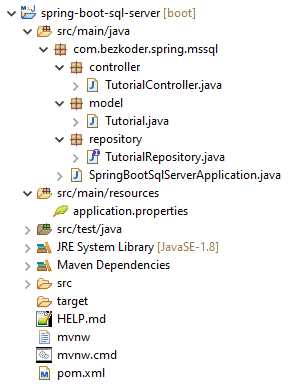
Let me explain it briefly.
– Tutorial data model class corresponds to entity and table tutorials.
– TutorialRepository is an interface that extends JpaRepository for CRUD methods and custom finder methods. It will be autowired in TutorialController.
– TutorialController is a RestController which has request mapping methods for RESTful requests such as: getAllTutorials, createTutorial, updateTutorial, deleteTutorial, findByPublished…
– Configuration for Spring Datasource, JPA & Hibernate in application.properties.
– pom.xml contains dependencies for Spring Boot and SQL Server.
We can improve the example by adding Comments for each Tutorial. It is the One-to-Many Relationship and I write a tutorial for this at:
Spring Boot One To Many example with JPA, Hibernate
Or add Tags with Many-to-Many Relationship:
Spring Boot Many to Many example with JPA, Hibernate
Create & Setup Spring Boot project
Use Spring web tool or your development tool (Spring Tool Suite, Eclipse, Intellij) to create a Spring Boot project with SQL Server maven dependency.
Then open pom.xml and add these dependencies:
<dependency>
<groupId>org.springframework.boot</groupId>
<artifactId>spring-boot-starter-data-jpa</artifactId>
</dependency>
<dependency>
<groupId>org.springframework.boot</groupId>
<artifactId>spring-boot-starter-web</artifactId>
</dependency>
<dependency>
<groupId>com.microsoft.sqlserver</groupId>
<artifactId>mssql-jdbc</artifactId>
<scope>runtime</scope>
</dependency>
Configure Spring Boot, JPA, SQL Server, Hibernate
Under src/main/resources folder, open application.properties and write these lines.
spring.datasource.url= jdbc:sqlserver://localhost:1434;encrypt=true;trustServerCertificate=true;databaseName=bezkoder_db
spring.datasource.username= zkoder
spring.datasource.password= 123456
spring.jpa.properties.hibernate.dialect= org.hibernate.dialect.SQLServerDialect
spring.jpa.hibernate.ddl-auto= update
spring.datasource.urlindicates database, host, port and database namespring.datasource.username&spring.datasource.passwordproperties are the same as your database installation.- Spring Boot uses Hibernate for JPA implementation, we configure
SQLServerDialectfor SQL Server. spring.jpa.hibernate.ddl-autois used for database initialization. We set the value toupdatevalue so that a table will be created in the database automatically corresponding to defined data model. Any change to the model will also trigger an update to the table. For production, this property should bevalidate.
Define Data Model
Our Data model is Tutorial with four fields: id, title, description, published.
In model package, we define Tutorial class.
model/Tutorial.java
package com.bezkoder.spring.mssql.model;
import javax.persistence.*;
// import jakarta.persistence.*; // for Spring Boot 3
@Entity
@Table(name = "tutorials")
public class Tutorial {
@Id
@GeneratedValue(strategy = GenerationType.AUTO)
private long id;
@Column(name = "title")
private String title;
@Column(name = "description")
private String description;
@Column(name = "published")
private boolean published;
public Tutorial() {
}
public Tutorial(String title, String description, boolean published) {
this.title = title;
this.description = description;
this.published = published;
}
public long getId() {
return id;
}
public String getTitle() {
return title;
}
public void setTitle(String title) {
this.title = title;
}
public String getDescription() {
return description;
}
public void setDescription(String description) {
this.description = description;
}
public boolean isPublished() {
return published;
}
public void setPublished(boolean isPublished) {
this.published = isPublished;
}
@Override
public String toString() {
return "Tutorial [id=" + id + ", title=" + title + ", desc=" + description + ", published=" + published + "]";
}
}
– @Entity annotation indicates that the class is a persistent Java class.
– @Table annotation provides the table that maps this entity.
– @Id annotation is for the primary key.
– @GeneratedValue annotation is used to define generation strategy for the primary key. GenerationType.AUTO means Auto Increment field.
– @Column annotation is used to define the column in database that maps annotated field.
Create Repository Interface
Let’s create a repository to interact with Tutorials from the database.
In repository package, create TutorialRepository interface that extends JpaRepository.
repository/TutorialRepository.java
package com.bezkoder.spring.mssql.repository;
import java.util.List;
import org.springframework.data.jpa.repository.JpaRepository;
import com.bezkoder.spring.mssql.model.Tutorial;
public interface TutorialRepository extends JpaRepository<Tutorial, Long> {
List<Tutorial> findByPublished(boolean published);
List<Tutorial> findByTitleContaining(String title);
}
Now we can use JpaRepository’s methods: save(), findOne(), findById(), findAll(), count(), delete(), deleteById()… without implementing these methods.
We also define custom finder methods:
– findByPublished(): returns all Tutorials with published having value as input published.
– findByTitleContaining(): returns all Tutorials which title contains input title.
The implementation is plugged in by Spring Data JPA automatically.
More Derived queries at:
JPA Repository query example in Spring Boot
Custom query with @Query annotation:
Spring JPA @Query example: Custom query in Spring Boot
You can modify this Repository:
– to work with Pagination, the instruction can be found at:
Spring Boot Pagination & Filter example | Spring JPA, Pageable
– or to sort/order by multiple fields with the tutorial:
Spring Data JPA Sort/Order by multiple Columns | Spring Boot
You also find way to write Unit Test for this JPA Repository at:
Spring Boot Unit Test for JPA Repository with @DataJpaTest
Finally, we create a controller that provides APIs for creating, retrieving, updating, deleting and finding Tutorials.
controller/TutorialController.java
package com.bezkoder.spring.mssql.controller;
import java.util.ArrayList;
import java.util.List;
import java.util.Optional;
import org.springframework.beans.factory.annotation.Autowired;
import org.springframework.http.HttpStatus;
import org.springframework.http.ResponseEntity;
import org.springframework.web.bind.annotation.CrossOrigin;
import org.springframework.web.bind.annotation.DeleteMapping;
import org.springframework.web.bind.annotation.GetMapping;
import org.springframework.web.bind.annotation.PathVariable;
import org.springframework.web.bind.annotation.PostMapping;
import org.springframework.web.bind.annotation.PutMapping;
import org.springframework.web.bind.annotation.RequestBody;
import org.springframework.web.bind.annotation.RequestMapping;
import org.springframework.web.bind.annotation.RequestParam;
import org.springframework.web.bind.annotation.RestController;
import com.bezkoder.spring.mssql.model.Tutorial;
import com.bezkoder.spring.mssql.repository.TutorialRepository;
@CrossOrigin(origins = "http://localhost:8081")
@RestController
@RequestMapping("/api")
public class TutorialController {
@Autowired
TutorialRepository tutorialRepository;
@GetMapping("/tutorials")
public ResponseEntity<List<Tutorial>> getAllTutorials(@RequestParam(required = false) String title) {
try {
List<Tutorial> tutorials = new ArrayList<Tutorial>();
if (title == null)
tutorialRepository.findAll().forEach(tutorials::add);
else
tutorialRepository.findByTitleContaining(title).forEach(tutorials::add);
if (tutorials.isEmpty()) {
return new ResponseEntity<>(HttpStatus.NO_CONTENT);
}
return new ResponseEntity<>(tutorials, HttpStatus.OK);
} catch (Exception e) {
return new ResponseEntity<>(null, HttpStatus.INTERNAL_SERVER_ERROR);
}
}
@GetMapping("/tutorials/{id}")
public ResponseEntity<Tutorial> getTutorialById(@PathVariable("id") long id) {
Optional<Tutorial> tutorialData = tutorialRepository.findById(id);
if (tutorialData.isPresent()) {
return new ResponseEntity<>(tutorialData.get(), HttpStatus.OK);
} else {
return new ResponseEntity<>(HttpStatus.NOT_FOUND);
}
}
@PostMapping("/tutorials")
public ResponseEntity<Tutorial> createTutorial(@RequestBody Tutorial tutorial) {
try {
Tutorial _tutorial = tutorialRepository
.save(new Tutorial(tutorial.getTitle(), tutorial.getDescription(), false));
return new ResponseEntity<>(_tutorial, HttpStatus.CREATED);
} catch (Exception e) {
return new ResponseEntity<>(null, HttpStatus.INTERNAL_SERVER_ERROR);
}
}
@PutMapping("/tutorials/{id}")
public ResponseEntity<Tutorial> updateTutorial(@PathVariable("id") long id, @RequestBody Tutorial tutorial) {
Optional<Tutorial> tutorialData = tutorialRepository.findById(id);
if (tutorialData.isPresent()) {
Tutorial _tutorial = tutorialData.get();
_tutorial.setTitle(tutorial.getTitle());
_tutorial.setDescription(tutorial.getDescription());
_tutorial.setPublished(tutorial.isPublished());
return new ResponseEntity<>(tutorialRepository.save(_tutorial), HttpStatus.OK);
} else {
return new ResponseEntity<>(HttpStatus.NOT_FOUND);
}
}
@DeleteMapping("/tutorials/{id}")
public ResponseEntity<HttpStatus> deleteTutorial(@PathVariable("id") long id) {
try {
tutorialRepository.deleteById(id);
return new ResponseEntity<>(HttpStatus.NO_CONTENT);
} catch (Exception e) {
return new ResponseEntity<>(HttpStatus.INTERNAL_SERVER_ERROR);
}
}
@DeleteMapping("/tutorials")
public ResponseEntity<HttpStatus> deleteAllTutorials() {
try {
tutorialRepository.deleteAll();
return new ResponseEntity<>(HttpStatus.NO_CONTENT);
} catch (Exception e) {
return new ResponseEntity<>(HttpStatus.INTERNAL_SERVER_ERROR);
}
}
@GetMapping("/tutorials/published")
public ResponseEntity<List<Tutorial>> findByPublished() {
try {
List<Tutorial> tutorials = tutorialRepository.findByPublished(true);
if (tutorials.isEmpty()) {
return new ResponseEntity<>(HttpStatus.NO_CONTENT);
}
return new ResponseEntity<>(tutorials, HttpStatus.OK);
} catch (Exception e) {
return new ResponseEntity<>(HttpStatus.INTERNAL_SERVER_ERROR);
}
}
}
– @CrossOrigin is for configuring allowed origins.
– @RestController annotation is used to define a controller and to indicate that the return value of the methods should be be bound to the web response body.
– @RequestMapping("/api") declares that all Apis’ url in the controller will start with /api.
– We use @Autowired to inject TutorialRepository bean to local variable.
Run & Test
Run Spring Boot application with command: mvn spring-boot:run.
tutorials table will be automatically generated in Microsoft SQL Server Database.
Create some Tutorials:
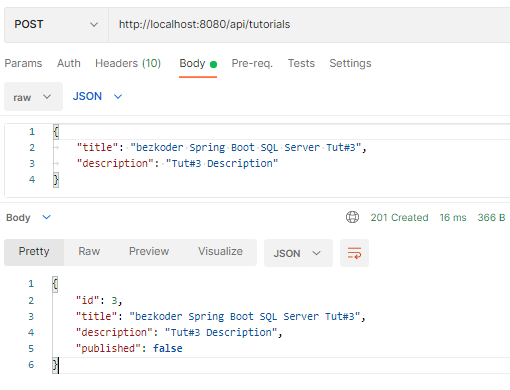
MSSQL tutorials table after that:

Retrieve All Tutorials:
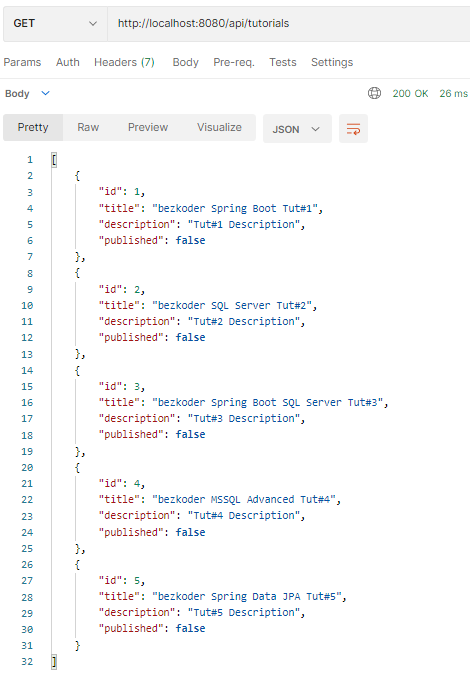
Retrieve a Tutorial by Id:
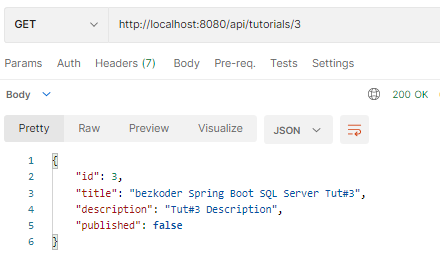
Update some Tutorials:
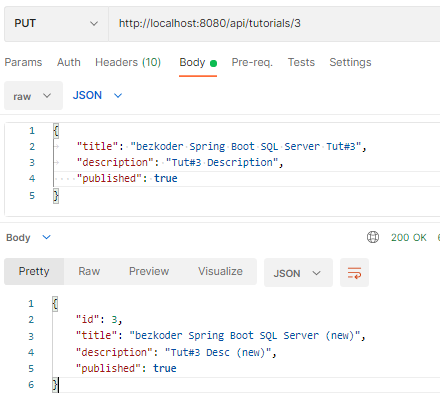
The table data is changed:

Find all Tutorials which title contains string ‘ring’:
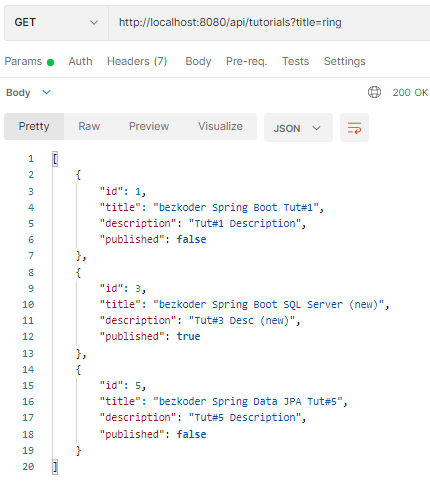
Find all published Tutorials:
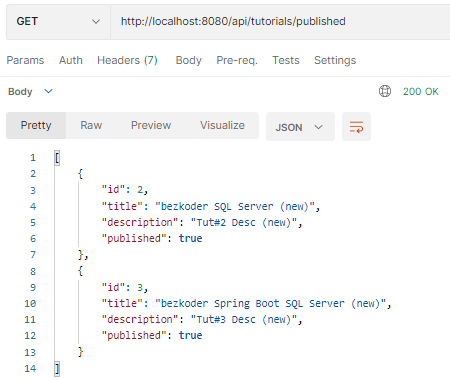
Delete a Tutorial:
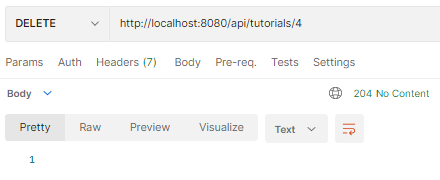

Delete all Tutorials:
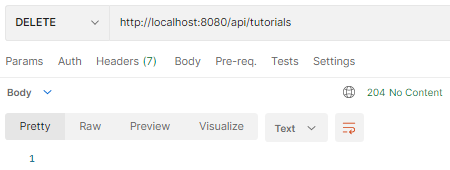
MSSQL database table is clean now:

You can also test this Spring Boot App with Client in one of these posts:
- Simple HTTP Client using Axios
- Simple HTTP Client using Fetch API
- Angular 8 CRUD Application example with Web API
- Angular 10 CRUD Application example with Web API
- Angular 11 CRUD Application example with Web API
- Angular 12 CRUD Application example with Web API
- Angular 13 CRUD Application example with Web API
- Angular 14 CRUD Application example with Web API
- Angular 15 CRUD Application example with Web API
- Vue 2 CRUD Application with Vue Router & Axios
- Vue 3 CRUD Application with Axios & Vue Router
- React CRUD example with Axios
- React Redux CRUD example
Handle SQLServerException TCP/IP connection
If you run the Spring Boot project and get the error:
com.microsoft.sqlserver.jdbc.SQLServerException: The TCP/IP connection to the host localhost, port 1434 has failed. Error: "Socket operation on nonsocket: configureBlocking. Verify the connection properties. Make sure that an instance of SQL Server is running on the host and accepting TCP/IP connections at the port. Make sure that TCP connections to the port are not blocked by a firewall."
Just follow these steps:
1. Open SQL Server Configuration Manager.
2. Expand SQL Server Network Configuration, and select Protocols for [INSTANCE_NAME].
3. Right-click TCP/IP, and select Enable.
4. Right-click TCP/IP, and click Properties.
5. Choose the IP Addresses tab.
6. Scroll down to IPALL node
Set TCP Dynamic Ports to the port (1434)
7. Restart SQL Server service.
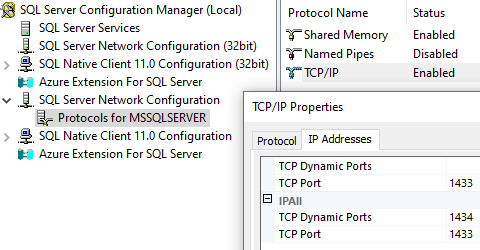
Conclusion
Today we’ve built a Rest API for CRUD operations example with Microsoft SQL Server (MSSQL) Database using Spring Boot, Spring Data JPA.
We also see that JpaRepository supports a great way to make CRUD operations and custom finder methods without need of boilerplate code.
Custom query with @Query annotation:
Spring JPA @Query example: Custom query in Spring Boot
If you want to add Pagination to this Spring project, you can find the instruction at:
Spring Boot Pagination & Filter example | Spring JPA, Pageable
To sort/order by multiple fields:
Spring Data JPA Sort/Order by multiple Columns | Spring Boot
Handle Exception for this Rest APIs is necessary:
– Spring Boot @ControllerAdvice & @ExceptionHandler example
– @RestControllerAdvice example in Spring Boot
Or way to write Unit Testing:
– Spring Boot Unit Test for JPA Repository
– Spring Boot Unit Test for Rest Controller
Happy learning! See you again.
Further Reading
Fullstack CRUD App:
– Spring Boot Thymeleaf example
– Spring Boot + Vue.js example
– Angular 8 + Spring Boot example
– Angular 10 + Spring Boot example
– Angular 11 + Spring Boot example
– Angular 12 + Spring Boot example
– Angular 13 + Spring Boot example
– Angular 14 + Spring Boot example
– Angular 15 + Spring Boot example
– React + Spring Boot example
More Practice:
– Secure Spring Boot App with Spring Security & JWT Authentication
– Spring Boot Rest XML example – Web service with XML Response
– Spring Boot Multipart File upload example
– Spring Boot Pagination and Sorting example
We can improve the example by adding Comments for each Tutorial. It is the One-to-Many Relationship and I write a tutorial for this at:
Spring Boot One To Many example with JPA, Hibernate
Or add Tags with Many-to-Many Relationship:
Spring Boot Many to Many example with JPA, Hibernate
Source Code
You can find the complete source code for this tutorial on Github.
More Derived queries at:
JPA Repository query example in Spring Boot
Using JdbcTemplate instead of JPA:
Spring Boot JdbcTemplate example with SQL Server
Other databases:
– Spring JPA + H2
– Spring JPA + PostgreSQL
– Spring JPA + MySQL
– Spring Data + MongoDB
Documentation: Spring Boot + Swagger 3 example (with OpenAPI 3)
Caching: Spring Boot Redis Cache example
Validation: Validate Request Body in Spring Boot

could you provide the postman collection as well for download?
Awesome Spring tutorial. Thanks!
Useful Spring tutorial. Lucky me Ι discovered yoսr web site accidentally. Thanks!